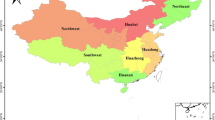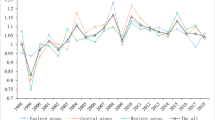Abstract
Based on the comprehensive evaluation system of agricultural green development index (AGDI), this paper uses entropy weight method and linear weighted sum method to measure the agricultural green development level of 31 provinces in China from 2013 to 2018. We then incorporate spatial correlation into the traditional convergence test model, study the spatial convergence of AGDI, and explore the reasons for regional differences in AGDI. The results show that the level of AGDI in China showed an overall growth trend during the sample survey period, but there were significant differences in the rate of AGDI among different regions, mainly manifested as “eastern > western > central.” The AGDI shows a significant positive spatial correlation on the whole, and its overall spatial distribution is characterized by high-high agglomeration and low-low agglomeration. The provinces with higher and lower level of AGDI still maintain the original relatively concentrated distribution in geographical space. On this basis, the study examines the regional differences of AGDI and its evolution by Dagum Gini coefficient decomposition and spatial convergence. The results showed that the overall difference of AGDI showed a fluctuating downward trend. The intra-regional difference of AGDI in the western region was the largest, and that in the eastern region was the smallest. The contribution rate of intensity of transvariation among regions was the main source of the relative difference of AGDI. Meanwhile, the AGDI of the overall, eastern, central, and western regions present significant σ convergence and conditional β convergence. Except for the central region, the overall, eastern, and western regions present significant absolute β convergence. The low-level areas of AGDI have significant “catch-up effect” on the areas with high-level AGDI. Based on the above results, this paper also puts forward some policy suggestions from the perspective of cross-regional collaborative governance to improve China’s agricultural green development mode and narrow the regional differences of China’s agricultural green development.






Similar content being viewed by others
Data availability
The datasets used and/or analyzed during the current study are available from the corresponding author on reasonable request.
Notes
The eastern region includes Beijing, Tianjin, Hebei, Liaoning, Shanghai, Jiangsu, Zhejiang, Fujian, Shandong, Guangdong and Hainan; the central region includes Shanxi, Inner Mongolia, Jilin, Heilongjiang, Anhui, Jiangxi, Henan, Hubei, Hunan and Guangxi; and the western region includes Sichuan, Guizhou, Yunnan, Tibet, Shaanxi, Gansu, Qinghai, Ningxia and Xinjiang.
The formula for the rate of convergence is \( \theta =-\frac{1}{T}\ln \left(1-\left|\beta \right|\right) \), where, T is the length of the sample investigation period.
References
Barnes AP, Soto I, Eory V, Beck B, Balafoutis A, Sánchez B, Vangeyte J, Fountas S, van der Wal T, Gómez-Barbero M (2019) Exploring the adoption of precision agricultural technologies: a cross regional study of EU farmers. Land Use Policy 80:163–174
Bastan M, Khorshid D, Reza R, Sisi S, Delshad A, Alimohammad (2018) Sustainable development of agriculture: a system dynamics model. Kybernetes the International Journal of Systems & Cybernetics
Bo LI, Zhang JB (2012) Study on carbon effects and spatial differences based on changes in China’s agricultural land use. Economic Geography:137–142
Chattopadhyay S, Majumder A, Jaman H (2014) Decomposition of inter-regional poverty gap in India: a spatial approach. Empir Econ 46:65–99
Chen P, Zhu X (2012) Regional inequalities in China at different scales. Acta Geograph Sin 67:1085–1097
Cheng W, Xi H, Sindikubwabo C, Si J, Zhao C, Yu T, Li A, Wu T (2020a) Ecosystem health assessment of desert nature reserve with entropy weight and fuzzy mathematics methods: a case study of Badain Jaran Desert. Ecol Indic 119:106843
Cheng ZH, Liu J, Li LS, Gu XB (2020b) Research on meta-frontier total-factor energy efficiency and its spatial convergence in Chinese provinces. Energ Econ 86:104702
Dagum C (1997) A new approach to the decomposition of the Gini income inequality ratio. Empir Econ 22:515–531
Dethier JJ, Effenberger A (2012) Agriculture and development: a brief review of the literature. Econ Syst 36:175–205
Dinar A, Zilberman D (1991) The economics of resource-conservation, pollution-reduction technology selection: the case of irrigation water. Resour Energy 13:323–348
Ge P, Wang S, Huang X (2018) Measurement for China’s agricultural green TFP. China PolulationResources and Environment:66–74
Griffiths W (2008) On Dagum’s decomposition of the Gini coefficient. William Griffiths
Guo HH, Liu XM (2020) Time-space evolution of China’s agricultural green total factor productivity. Chinese Journal of Management Science 28:66–75
Guo F, Tong L, Xu L, Lu X, Sheng Y (2020a) Spatio-temporal pattern evolution and spatial spillover effect of green development efficiency: evidence from Shandong Province, China. Growth Chang 51:382–401
Guo X, Huang S, Wang Y (2020b) Influence of agricultural mechanization development on agricultural green transformation in Western China, based on the ML index and spatial panel model. Math Probl Eng 2020:6351802
Jovanović V, Cummins RA, Weinberg M, Kaliterna L, Prizmic-Larsen Z (2019) Personal wellbeing index: a cross-cultural measurement invariance study across four countries. J Happiness Stud 20:759–775
Klomp J, Hoogezand B (2018) Natural disasters and agricultural protection: a panel data analysis. World Dev 104:404–417
Kumari M, Sarma K, Sharma R (2019) Using Moran’s I and GIS to study the spatial pattern of land surface temperature in relation to land use/cover around a thermal power plant in Singrauli district, Madhya Pradesh, India. Remote Sensing Applications: Society and Environment 15:100239
Li Q, Zhong S (2016) Spatial imbalance and its evolution of China’s tourism industry specialization development—based on empirical study of Dagum Gini coefficient and Markov chain. Economic Geography:197–203
Li J, Huang X, Yang H, Chuai X, Wu C (2017) Convergence of carbon intensity in the Yangtze River Delta, China. Habitat International 60:58–68
Li W, Xi YQ, Lu JY, Wu FM, Wu PF (2019) Interactive relationships “between industrial”, urban, agricultural, information, and green development. Energ Environ-Uk 30:991–1009
Li X, Wang J, Zhang M, Ouyang J, Shi W (2020) Regional differences in carbon emission of China’s industries and its decomposition effects. J Clean Prod 270:122528
Lim U (2016) Regional income club convergence in US BEA economic areas: a spatial switching regression approach. Ann Reg Sci 56:273–294
Liu Y, Sun D, Wang H, Wang X, Yu G, Zhao X (2020) An evaluation of China’s agricultural green production: 1978–2017. J Clean Prod 243:118483
Liu D, Zhu X, Wang Y (2021) China’s agricultural green total factor productivity based on carbon emission: an analysis of evolution trend and influencing factors. J Clean Prod 278:123692
Lu Y, Jenkins A, Ferrier RC, Bailey M, Gordon IJ, Song S, Huang J, Jia S, Zhang F, Liu X, Feng Z, Zhang Z (2015) Addressing China’s grand challenge of achieving food security while ensuring environmental sustainability. Sci Adv 1:e1400039–e1400039
Motamed MJ, Florax RJGM, Masters WA (2014) Agriculture, transportation and the timing of urbanization: global analysis at the grid cell level. J Econ Growth 19:339–368
Of M (2002) Review and prospect of development of agricultural science and technology in China in recent and modern times. World Sci-tech R & D 2:1–7
Peng Y, Chen Z, Lee J (2020) Dynamic convergence of green total factor productivity in Chinese cities. Sustainability 12:4883
Qi Y, Han S, Deng X (2020) China’s green agriculture development: production level measurement, regional spatial difference and convergence analysis. Journal of Agrotechnical Economics:51–65
Qin XH, Du DB, Kwan MP (2019) Spatial spillovers and value chain spillovers: evaluating regional R&D efficiency and its spillover effects in China. Scientometrics 119:721–747
Rafiq S, Salim R, Apergis N (2016) Agriculture, trade openness and emissions: an empirical analysis and policy options. Aust J Agr Resour Ec 60:348–365
Robson SA (1970) Agriculture and economic growth. J Agric Econ 21:215–223
Shen Z, Baležentis T, Chen X, Valdmanis V (2018) Green growth and structural change in Chinese agricultural sector during 1997–2014. China Econ Rev 51:83–96
Tu Z, Gan T (2019) Research on the regional difference and dynamic mechanism of agricultural green development in China. Wuhan University Journal (Philosophy & Social Sciences):165–178
Wagner M, Zeileis A (2019) Heterogeneity and spatial dependence of regional growth in the EU: a recursive partitioning approach. Ger Econ Rev 20:67–82
Wang Q, Wang H, Chen H (2012) A study on agricultural green TFP in China: 1992–2010. Econ Rev:24–33
Wei Q, Zhang B, Jin S (2018) A study on construction and regional comparison of agricultural green development index in China. Issues in Agricultural Economy:11–20
Xu B, Chen W, Zhang G, Wang J, Ping W, Luo L, Chen J (2020) How to achieve green growth in China’s agricultural sector. J Clean Prod 271:122770
Yang Q, Wang Y, Li C, Liu XP (2019) The spatial differentiation of agricultural green total factor productivity and its driving factor recognition in China. The Journal of Quantitative & Technical Economics 10:21–37
Yu J, Wu J (2018) The sustainability of agricultural development in China: the agriculture–environment nexus. Sustainability 10:1776
Yu S, Hu X, Zhang X, Li Z (2019) Convergence of per capita carbon emissions in the Yangtze River Economic Belt, China. Energ Environ-Uk 30:776–799
Yu C, Wenxin L, Khan SU, Yu C, Jun Z, Yue D, Zhao M (2020) Regional differential decomposition and convergence of rural green development efficiency: evidence from China. Environ Sci Pollut Res 27:22364–22379
Zhang F, Chen X, Vitousek P (2013) Chinese agriculture: an experiment for the world. Nature 497:33–35
Zhang N, Zhang L, Zhao H, Han Y, Duan Y (2018) Construction and application of evaluation index system for agricultural green development. Ecological Economy 112:21–24
Zhang H, Geng Z, Yin R, Zhang W (2020) Regional differences and convergence tendency of green development competitiveness in China. J Clean Prod 254:119922
Acknowledgments
The authors are grateful to two anonymous reviewers and editors for their insightful comments that helped us sufficiently improve the quality of this paper. The authors would like to express their gratitude to EditSprings (https://www.editsprings.com/) for the expert linguistic services provided.
Funding
This work is financially supported by the National Social Science Foundation of China (17BJY137), Shaanxi Soft Science Joint Project (2018KRLZ04), and Northwest A&F University basic scientific research operating expenses humanities and social sciences major cultivation project (2452020055).
Author information
Authors and Affiliations
Contributions
Conceptualization: Zhe Chen, Xiaojing Li; methodology: Zhe Chen, Xiaojing Li; formal analysis and investigation: Zhe Chen, Xiaojing Li; writing—original draft preparation: Zhe Chen; writing—review and editing: Zhe Chen, Xiaojing Li; funding acquisition: Xianli Xia; resources: Xianli Xia; supervision: Xianli Xia
Corresponding author
Ethics declarations
Ethical approval
Ethical approval was obtained from the School of Economics and Management, Northwest Agriculture & Forestry University.
Consent to participate
Not applicable.
Consent to publish
Not applicable.
Competing interests
The authors declare that they have no conflict of interests.
Additional information
Responsible Editor: Eyup Dogan
Publisher’s note
Springer Nature remains neutral with regard to jurisdictional claims in published maps and institutional affiliations.
Rights and permissions
About this article
Cite this article
Chen, Z., Li, X. & Xia, X. Measurement and spatial convergence analysis of China’s agricultural green development index. Environ Sci Pollut Res 28, 19694–19709 (2021). https://doi.org/10.1007/s11356-020-11953-z
Received:
Accepted:
Published:
Issue Date:
DOI: https://doi.org/10.1007/s11356-020-11953-z




